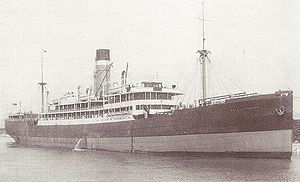SS City of Venice

| |
| Career | |
|---|---|
| Name: | SS City of Venice |
| Operator: | Ellerman Lines Ltd, London |
| Builder: | Workman, Clark & Co Ltd, Belfast |
| Completed: | 1924 |
| Fate: | sunk on 4 July 1943 |
| General characteristics | |
| Class and type: | Steam passenger ship |
| Tonnage: | 8,762 tons |
| Crew: | 158 |
The SS City of Venice was a British passenger steamer, sunk in the Second World War. She was built by Workman, Clark & Co Ltd, Belfast for Ellerman Lines Ltd, of London in 1924. She was homeported in Glasgow.
Wartime career and sinking
The City of Venice was used for numerous duties in the Second World War, including service as a troop transport. Her final duty was to take part in Operation Husky, the Allied invasion of Sicily in 1943. Under the command of her Master, James Wyper, she was part of the military convoy KMS-18B, carrying 292 troops of the 1st Canadian Infantry Division and 700 tons of military equipment. She left the Clyde on 24 June bound for Algiers. At 21.40 hours on 4 July, the convoy was sighted and attacked by U-375. The U-boat fired a spread of four torpedoes at the convoy, by now 10 miles north of Cape Tenez, Algeria. She then reported the sinking of a freighter, but had in fact hit and sunk two ships, the SS St. Essylt and the City of Venice.
The master, ten crew members and ten troops were lost in the sinking, while 147 crew members, 22 gunners, 282 troops and ten naval personnel were rescued by the Flower class corvettes HMS Honeysuckle and HMS Rhododendron, the River class frigate HMS Teviot and the rescue tug Restive. The survivors were then landed at Algiers.
